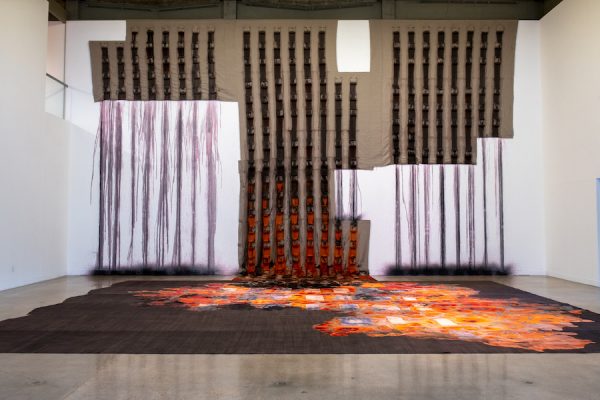
Carmen Argote: Me At Market, installation view, Visual Arts Center, University of Texas at Austin, January 24 –March 6, 2020. Photo: Sandy Carson.
I first met Carmen Argote in the summer of 2019, when she and I crossed paths in Guadalajara. At the time she was toward the end of a residency at Taller de los Guayabos, and had just produced an exhibition and performance at PAOS, a well-respected contemporary art institution. Carmen had imbedded herself in the city and its art community, and built a sense of trust in her vision and practice unlike anything I’d seen from a visiting artist in a very long time.
She’s also produced a large-scale installation, Me At Market, for the Visual Art Center (VAC) at the University of Texas at Austin (through March 6). Recently, I had a chance to catch up with her to talk about her process and her work.
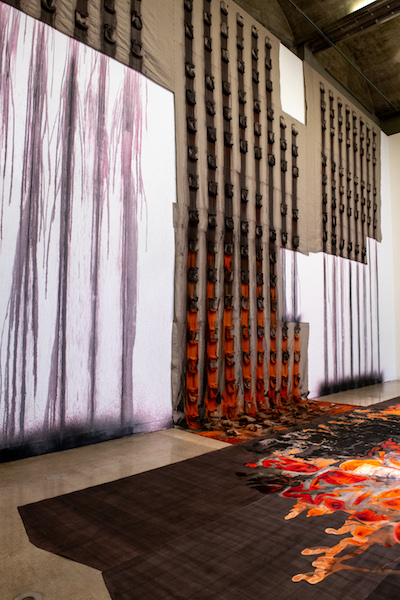
Carmen Argote: Me At Market, installation view, Visual Arts Center, University of Texas at Austin, 2020. Photo: Sandy Carson.
Leslie Moody Castro: You poetically reference systems of labor and consumption in your work and practice. Can you tell me a little bit more about how you do that?
Carmen Argote: The weight of love and labor and time that had gone into this work was a felt presence. It was something that confronted me while I was in process. My mother, Carmen Vargas, had taken on this project with me in what I would say was an act of love. My mother and grandmother (who also helped in the sewing of Me At Market) worked in the fashion industry for many years. My grandmother was a professional seamstress and my mother worked as a pattern maker, deciphering and interpreting the sketches of the garments to be made. As a pattern-maker she might take on the role of the sample-maker, seamstress and also be requested to modify the pattern numerous times until it was to the satisfaction of the designer. This is the labor of the trade: a highly skilled, multi-step creative process and act of problem-solving carried out because it was her job to do so. However, the labor of the process was not part of the conceptual framework of the final idea or design, though it was necessary and expected in order to interpret the final design technically.
The idea/finding of the artistic gesture for Me at Market came when my mother and I were preparing to go to Madrid to work on a collaborative backpack walking project/artwork for Arco Madrid, the art fair. The project involved using two large, used vintage hiking backpacks and walking the city while collecting trash and found remnants, then transforming them and incorporating them onto these backpacks to make two moving sculptures. All the while we used different Airbnb rooms as our studio.
At the time I was also talking with her about making a kind of pocket painting. I imagined these balcony-like structures made of thick linen, and I could see myself pouring some kind of liquid into them and the liquid would drip down through the pocket because the fabric can’t hold liquid. She would listen to the idea and start imagining — perhaps how to go about making it, maybe trying to see it herself. The labor of listening to an artist flesh out their ideas, of taking in, or filtering, is so important for me. It is needed in every artwork pretty much: “someone please listen … I have this idea.” Looking around, I spotted the pocket on the vintage hiking backpack and asked, “Can we use this, can you make this pattern?” “Send me a picture,” she replied, “let me look at it.”
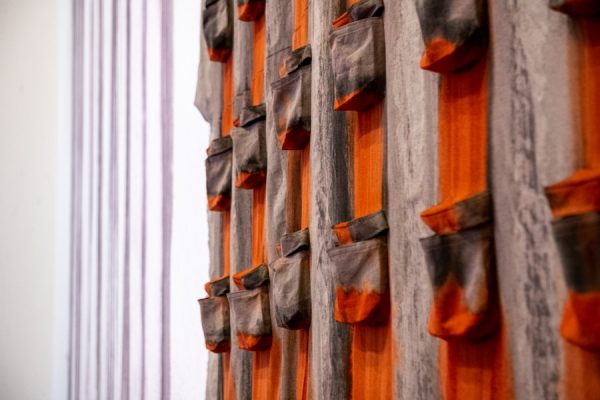
Carmen Argote: Me At Market, installation view, Visual Arts Center, University of Texas at Austin, 2020. Photo: Sandy Carson.
Fast forward to our Airbnb in Madrid. The pocket painting had the pockets laid out on a grid, kind of like balconies that align vertically, and I poured wine and coffee into them which seeped through and dripped down to make a mark. I remember the moment I recognized that the drips made thick, abstract vertical lines deconstructing the grid, and I felt the artwork flip. It functioned as abstraction, gained complexity of meaning, and became understood as more than the action of its process.
The labor of being an artist is a constant navigation in an attempt to maintain the integrity of my work and practice. Me At Market, in many ways, is about this labor of negotiating one’s practice within an art market and economic structure that digests, consumes, and has a tendency to decentralize the artist’s practice and place at the center of the art market’s demands and profit. The art is also usually sold at a discount.
The disembodied artist, the artist without integrity, can more easily navigate this economic structure by repeating patterns of exploitation, further decentralizing the art, and perhaps the art practice they would like to have, and evolving into an art practice that just keeps the studio going.
I don’t want to give all my money to FedEx.
I trust myself and know myself as an artist and I trust my practice.
My body is the studio, the city is the studio.
I use walking as a very important part of my thinking process.
The idea of going to a place ( let’s say in this case the VAC) without a preconceived picture in my head of what I want to make and put in the space allows me to find surprise and complexity in my process. It allows me to connect with the gestures that often exist as fragments (that pocket painting in Spain) of poetic visual interactions between materials — maybe it’s something I saw while I was walking — that shape the visual language and materiality of the work.
LMC: How does your immediate environment affect your process? How does your process change if your environment does? Or does your process change at all?
CA: For Me At Market, I started by spending some time in space and felt the impact of VAC’s large and open gallery. There is also a courtyard space that felt smaller in comparison to the gallery but was actually very similar in square footage and shape. I felt a shift in the scale of my body between the two spaces, and I used this as an entry point to begin searching for an idea to begin with.
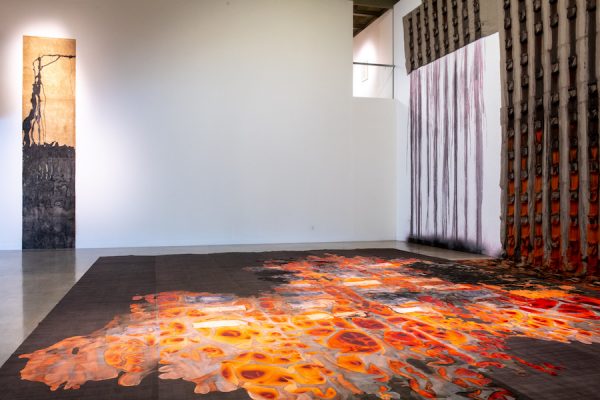
Carmen Argote: Me At Market, installation view, Visual Arts Center, University of Texas at Austin, 2020. Photo: Sandy Carson.
I imagined bringing the shape of the outside in, then flipping it vertically onto the large central wall. The idea was to somehow reveal the scale of both similarly sized, cube-like spaces — indoor and outdoor — even though the two don’t feel like they are actually the same size. I was also drawn to the relative use and expectation for both spaces because the courtyard seemed so underused and the gallery is given so much importance.
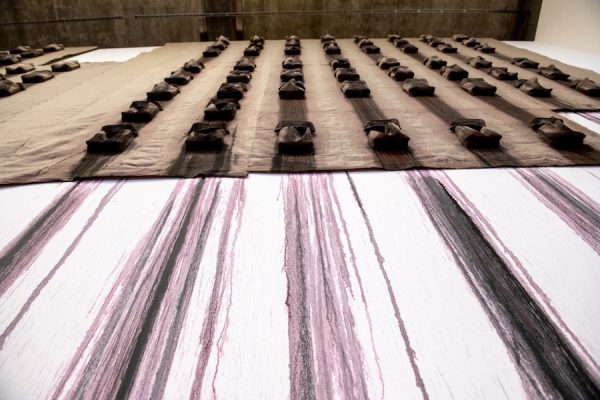
Carmen Argote: Me At Market, installation view, Visual Arts Center, University of Texas at Austin, 2020. Photo: Sandy Carson.
Looking down onto the courtyard slabs, I noticed how they were composed into the shape of the space. I decided then to do a 1:1 pattern/rubbing of these slabs. This brought to mind a possible solution, the linen fabric, which then reminded me of the pocket paintings which made me remember the gesture of the pouring of the wine into abstract lines in Madrid. I started to imagine the deconstruction of the grid of pockets into huge lines made by pouring. I started to think about the gallery as a huge studio that allowed for these gestures of gravity to really be taken to an architectural scale. I thought of reactions, transformation and alchemy, and it took me to working with cochineal, which shifts colors from a deep purple to a bright red depending on the pH of its surface. I also thought of tapestries I had seen in Zaragoza, Spain that used cochineal. I thought of the americas and huipiles, and I thought of the energy and charge of the dye material. I thought of how the material would feel at that scale, at that level of abstraction, in conversation with the grid, with the tailoring and sewing of the balcony pockets, and I thought of the architecture.
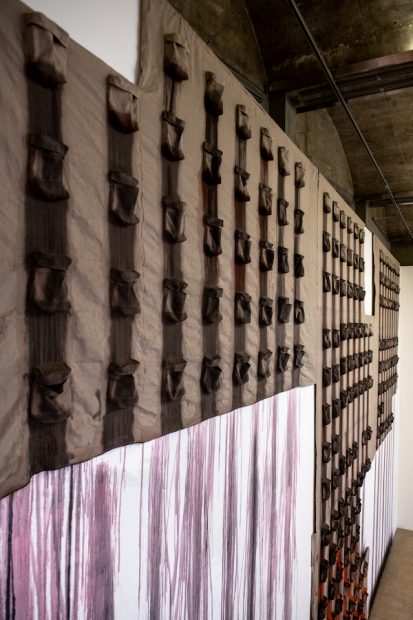
Carmen Argote: Me At Market, installation view, Visual Arts Center, University of Texas at Austin, 2020. Photo: Sandy Carson.
This is how the materials reveal themselves for a work — by remembering fragments of a gesture, by waiting and allowing those memories and experiences to begin to shape the visual language for the work.
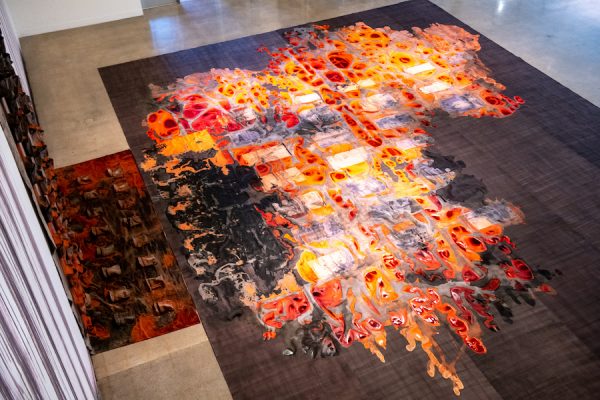
Carmen Argote: Me At Market, installation view, Visual Arts Center, University of Texas at Austin, 2020. Photo: Sandy Carson.
LMC: I’ve seen three projects that you’ve done and they all relied heavily on dyes and textiles. Talk to me about why textiles and natural dyes are so important to you.
CA: I’ve used all kinds of materials, from motorcycles and fiberglass to birdseed, to photography and video. I enjoy the fragility and ephemerality of works on paper and the associations of linen with painting. I don’t have a set of materials that I work with, nor am I drawn to natural dying for its own sake. I began to use natural dyes in Bogota for a project called Deterioro because I was thinking about different ways people have processed nature, and as a way to understand herbs, since I have very little knowledge of plants. The simple question of “what color will this give me?” as a way to converse with what I don’t know was an entry point.
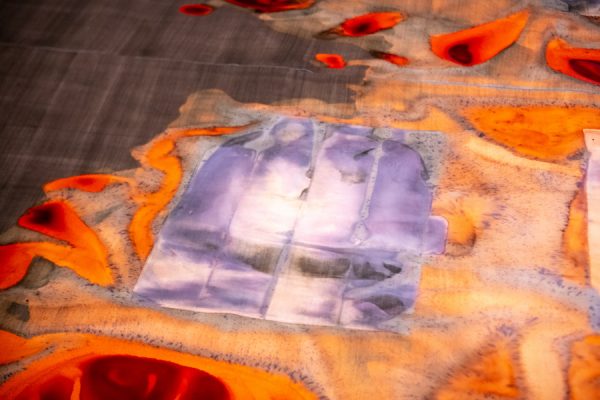
Carmen Argote: Me At Market, installation view, Visual Arts Center, University of Texas at Austin, 2020. Photo: Sandy Carson.
I’ve used coffee, cochineal, tannic acid from guayaba tree leaves, avocado pits and chestnut tree bark, iron sulfate and wine, some various foods, etc. I don’t use these materials because they are natural dyes — I use them because in the case of the work in Guadalajara, Manejese Con Cuidado, the central courtyards had trees that had those materials, and conversed with the market and the economic structures I am interested in. I use coffee because I relate it to my body as a liquid I constantly ingest. I use cochineal because of its visceral charge, because it’s made of dead insects, and because of its historical weight. I also use it because of its changes in pH, which I feel retains a visual charge that is felt very differently from the predictability of pigment in paint. Paint and pigment is designed to reflect light in a very specific way; a stain or dye does not.
LMC: Can you tell us a little bit about the title of the piece at the VAC? What is the story of the title, how did you come up with it, and what does it reference?
CA: Me At Market references a wall text at a meat market that I saw while walking in the Lincoln Heights neighborhood of Los Angeles. Walking is very important to me as a thinking process. First, it takes a lot of time and deconstructs my notions of productivity, forcing me to let go and take notice of my immediate environment. It is a way for me to remain embodied, aware, and not defiant as a daily process. This creates a space where ideas can enter without being preconceived, and be connected through this act of being in motion. In a way, it can be understood as a sort of meditation, or it can simply be interpreted as being in the studio.

Carmen Argote: Me At Market, installation view, Visual Arts Center, University of Texas at Austin, 2020. Photo: Sandy Carson.
Me at Market as a title expresses my resistance to be bought and sold like a piece of meat. It is a title that helps me think about ways to keep my integrity as a person and as an artist in our society. It is a reminder to myself to not be used and marketed in a way that does not put my artwork first. It is a reminder to myself that I am for sale, that I am already in the system, and that as an artist I always have a choice.
LMC: The piece at the VAC also uses garments from UT’s Art and Art History Collection which are regional to Central and South America. Where were these garments before and how did you manipulate them to become incorporated into your piece?
CA: I did not end up including any of the garments in the exhibition. The collection and its garments were a part of my thinking, in terms of the institution as a context for the materials I was using, especially cochineal. I had a ziplock bag filled with concentrated cochineal dye that I put in the freezer of the staff kitchen and it exploded one day. Somehow this seems relevant.
Carmen Argote’s ‘Me At Market’ through March 6 at the VAC, University of Texas at Austin


